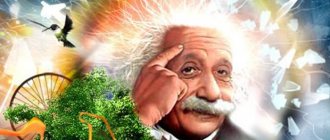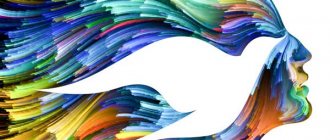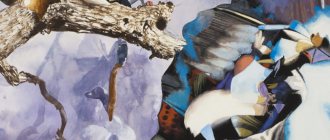Specific Characteristics of Imagination
- Imagination is aimed at creating something new; it is a process involving the creation of new images, ideas and ideas. In this regard, imagination allows a person to go beyond personal experience.
- The new created in the process of imagination is connected with what has already been perceived by a person. Elements of the new, created by the imagination, represent what is already known, existing in reality, but the imagination transforms the relationships between really existing objects and thereby achieves the effect of novelty.
- Imagination is inextricably linked with a person’s personality; A particularly close connection is found between imagination and personality orientation. A significant role in determining the direction in which the imagination develops is played by the orientation of the individual - interests that create special centers of emotional sensitivity associated with them. The activity of imagination is generated by the transformative effect of orientation on images of consciousness that reflect reality.
Techniques
What are the techniques of imagination?
Agglutination
Agglutination is an operation in which elements related to different phenomena or objects are combined to create something new.
This technique can often be found in mythology, fairy tales and legends of different peoples of the world, in works of art written in the genres of fantasy and science fiction.
Examples of agglutination:
- Sea maiden. Traditionally, sea maidens are attractive girls with a fish-like tail instead of legs, existing in European mythology. In Russian they are usually called mermaids, despite the fact that classic mermaids, taken from Slavic mythology, do not have a tail.
- Sphinx. This mythical creature became quite famous, and many peoples depicted it in different ways. The most famous image of the sphinx, a creature with the body of a lion and a human head.
- Centaur. A famous mythical creature, half man, half horse, which migrated from myths to many famous fantasy universes, for example, to the Harry Potter universe.
- A hut on chicken legs. An ominous attribute in many Russian folk tales: a hut standing on strong legs (two or four) reminiscent of chickens, often able to move with their help and behaving like a relatively intelligent creature.
- Animals from the popular animated series “Avatar: The Last Airbender” and “Avatar: The Legend of Korra”. In the fantasy universe of these animated series, there are a huge number of animals created using the “agglutination” technique: mole badgers, lion turtles, rabbits (rabbit and kangaroo), turtle crabs, platypus bears and many others.
- Hippogriff from the Harry Potter series of books and films. According to the description in the books, the hippogriff is a large animal that is a mixture of a horse (torso, tail and hind limbs) and an eagle (head, wings and forelimbs). May have different colors.
Mechanisms of imagination
- Agglutination (gluing) is the unification into a single whole of a number of ideas in a sequence different from our direct perceptions and experiences.
- Emphasis – emphasizing the most significant, typical features of an object.
- Hyperbolization and miniaturization - exaggeration and understatement, changing the proportions of elements involved in the process of imagination, or their parts. S.L. Rubinstein considered this imaginative technique to be one of the types of emphasis.
- Schematization is the selection of those properties of an element that are significant for the content of a specific act of imagination, the mental exclusion of some properties or qualities inherent in a particular object, getting rid of unnecessary and minor details.
The world of imagination: imagination in psychology
Imagination in psychology is understood as a complex mental process that creates new images of objects, situations and phenomena based on past perceptions. Simply put, imagination is the creation of something new from something old. Imagining what a long-destroyed ancient temple looks like based on its description, or inventing a non-existent animal with horns and wings, uses already known elements so that we understand what something that does not actually exist at the moment looks like.
Thinking and imagination
The specificity of the concept of imagination is that it is difficult to separate it from the same visual-figurative thinking (operating with images, rather than verbal units - words, syllables, phrases, calls, etc. - to solve a problem, without using objects from this task in real life). For a long time there was an idea that the imagination is capable of creating thoughts, which are essentially psychically formed connections between images and/or knowledge. But such an approach could not exist for long, because then thinking, as a mental process, would have no meaning. Scientists have come to the conclusion that the main distinguishing feature of the imagination will be the creation of new, previously unperceived images by humans. A.V. Brushlinsky, a Soviet and Russian psychologist, emphasizes the close relationship between thinking and imagination based on the fact that the imagination operates with the products of thinking (communications, inferences, analysis, synthesis and abstraction), and thinking itself is based on those sensory images that the imagination creates .
Types of imagination
Today in psychology the following types of imagination are distinguished:
- the reproductive creates an image, the elements of which are already known to man. For example, when describing a middle-aged literary character who has blue eyes and a mustache, we use several elements we already know (in this case, the face of a middle-aged man, blue eyes and a mustache). This also includes reproducing what the house will look like based on its drawing.
- productive imagination, which is also called creative , involves the creation of images that are unlike anything the subject has ever perceived. Already known elements are also used here, but, unlike the reproductive type, the creative imagination creates something that, in fact, does not exist in reality. For example, we have two elements - lilac and wild fox. By combining them, we create something that, in our opinion, does not exist in reality, namely, a lilac fox.
- Passive imagination is that imagination that acts without our volitional efforts. An example here is a dream or hallucination.
- active imagination, accordingly, is necessarily accompanied by our intention to imagine or invent something.
- concrete imagination is based on a visual representation of objects.
- abstract imagination operates with generalized images, namely symbols (verbal and non-verbal), diagrams and ideas.
- plastic imagination, which L.S. Vygotsky, known for his cultural-historical concept, describes as something that borrows its elements from the outside (can be called objective).
- vague – the one that operates with more emotional images (can be called subjective).
There is also a categorization of imagination based on the scope of its application. For example, the French psychologist and teacher of the late 19th century Theodule Ribot gives the following types:
- mystical, which uses symbols,
- scientific, which is more rational,
- practical and mechanical, the images of which can turn into speech (verbal) form,
- in the field of trading, often based on intuition,
- in the sphere of utopia, where it is a mirror for social and ethical relations.
Mechanisms of imagination
At the moment, the following mechanisms of imagination are known in psychology, allowing it to perform its functions:
- Hyperbolization is an exaggeration of the qualitative or quantitative properties of an object (a huge problem, a billion mosquitoes, etc.).
- Litotes is an understatement, the reverse mechanism of hyperbolization.
- Sharpening or accentuation - emphasizing individual features (an example would be caricatures where a chatterbox has a long tongue, and a liar has a nose).
- Agglutination ( combination ) - the combination of two elements (a green cloud, a dog the size of an elephant, a book with wings, etc.)
- Schematization - ordering, generalization of elements into a clear structure (ornaments, paintings).
- Typification is highlighting something common in several images and assigning them to a separate group (doctors, representatives of the cat family, fiction books, etc.).
The Meaning of Imagination
The importance of imagination is reflected in any life situation, and some of its functions are unique to humans, which makes our stage of development of imagination in phylogeny one of the distinctive features of humans as a species. Imagination has become an important asset of the human psyche due to its following functions:
- Regulation of an individual's emotional states . For example, imagination can play a compensatory role, helping a person avoid frustration - a state caused by a discrepancy between what is desired and the ability to achieve it. A classic example of the study of this particular function of the imagination is the theories of psychoanalysis.
- Regulation of human physiological states . Research has shown that the process of imagination can cause activity in quite a few areas of the brain, including the hypothalamic-limbic system. Therefore, it is quite logical to draw a conclusion about the influence of this process on our body. A striking example is that on every anniversary of St. Bartholomew's Night, the famous philosopher Voltaire's temperature rose at the sole thought of the thousands of murdered Huguenots in 1572.
- Solving problems based on operating with images. When solving problems with a sufficient amount of known data, we use thinking, but when this data is too little, and we need to go beyond the usual system for solving a problem, we use imagination. Thus we can say that thinking creates theories, and imagination creates hypotheses.
- Anticipation . In order to come up with a plan of action that we want to carry out in the future, we need to use our imagination. After all, as mentioned earlier, to solve a problem with many unknowns, which is our future, we use not so much thinking as imagination. In order to be confident in your plan, you must first play it out in your head. We can say that our memory is a look into the past, thinking into the present, and imagination into the future.
- Planning and programming of activities . Having built and played out a plan of action in our head, we also tune in to this activity with the help of our imagination. This process is a symbiosis of the functions of anticipation (prediction) and regulation. A.R. Luria, one of the founders of neuropsychology, described the situation that happened to Solomon Shershevsky, known for his phenomenal memory, when he was preparing to speak in court. He imagined the trial in his head, imagining that the judge was on the right. But when Shershevsky arrived in court, the judge was sitting to his left, because of which all his logic disappeared, he was confused, and the case was lost.
In addition to its functions as a mental process, imagination also plays its role as the cause of a person’s individual characteristics. How and how much a person used his imagination influences the manifestation of creative activity, will, inclination and desire for a specific type of activity. Within the framework of his socio-historical concept, Vygotsky devotes an entire book to the problem of the role of imagination in the formation of an individual’s personal characteristics - “Imagination and Creativity in Childhood.”
Fantasy and imagination
Some authors consider fantasy and imagination as synonymous concepts, but they should be separated. At its core, fantasy is a product of the imagination, the distinctive feature of which can be called its unrealization. It is designed to perform a compensatory function to regulate emotional states; can be active or passive, mainly considered as a reproductive process. When fantasizing, we are not aimed at realizing the content of our fantasies, which are intimate for us, and their source is in our unconscious. However, fantasies can push us to actions that will use our already productive imagination. This chain is the basis for many works of art and scientific discoveries.
Types of imagination
- Active (voluntary) imagination is a conscious, purposeful process, always aimed at fulfilling a creative or personal task. The participation of volitional processes in this case is maximum: the process of active imagination is controlled and directed by the person himself. Active imagination is divided into active recreative and active creative imagination. Active recreating imagination consists of imagining something that is not directly perceived by the senses, but created in the mind in accordance with the description (for example, in the process of listening to an interlocutor, reading books).
- Unlike active recreation, the process of active creative imagination occurs without relying on description. This process is carried out by a person independently (for example, the work of an artist, writer).
- Passive intentional imagination is a type of imagination whose products are dreams and daydreams. This is the creation of an image of the desired future, which can act as a unique form of psychological protection, providing temporary escape from problems that have arisen, which contributes to a certain neutralization of the negative mental state and ensuring the preservation of regulatory mechanisms while reducing the overall activity of a person. What a person needs, but which he cannot achieve in reality, while having a strong need, is achieved in a passive voluntary imagination in order to get out of the state of frustration.
Basic Concepts
Imagination is not only a tool of a creative person.
It is valuable for a representative of any profession, because it allows you to think creatively and go beyond standard ideas.
Fantasy makes it possible not only to create from scratch, but also to imagine images and diagrams without errors in the process of reading scientific and fiction literature, to solve problems directly related to the use of visual-figurative thinking, to plan future activities, and to memorize information more effectively.
Active (one that works voluntarily) imagination is divided into:
- Recreating. This is a person’s ability to recreate images, models, diagrams in his head based on a description, which is usually given either orally or in writing.
For example, the reconstructive imagination is actively involved while reading fiction books: the reader imagines in detail the characters, setting, actions, intonation, and so on. - Creative. This is the ability to create original images, concepts, and diagrams. Of course, any creative person relies on already existing concepts, rules, ideas, creating something of his own, but at the same time, the product of his imagination will differ to one degree or another from everything that existed before.
Techniques or, in other words, operations of the imagination are directly related to creative imagination .
Creative imagination largely works on the basis of the “analysis-synthesis” scheme: first, the images existing in a person’s memory are analyzed, their characteristics and relationships are determined, then a splitting process occurs in order to construct something new from the resulting material.
Operations of imagination are methods by which fantasy carries out the process of analysis and synthesis.
The main operations of imagination are agglutination, hyperbolization, addition, typification, emphasis, transfer, analogy.









